Table of Contents:
- Early Beginnings of WordPress
- The history of WordPress from its beginning to the present
- WordPress 0.71 – (June 2003)
- The history of WordPress from its beginning to the present day. Version 1.0
- WordPress 1.0.1 – Miles (2004)
- WordPress 1.2 – Mingus (May 2004)
- WordPress 1.5 – Strayhorn (February 2005)
- The history of WordPress from its beginning to the present. Version 2.0
- WordPress 2.0 – Duke (December 2005)
- WordPress 2.3 – Dexter (September 2007)
- WordPress 2.5 – Brecker (March 2008)
- WordPress 2.9 – Carmen (December 2009)
- The history of WordPress from its beginning to the present. Version 3.0
- WordPress 3.0 – Thelonious (2010)
- WordPress 3.8 – Parker (2013)
- The history of WordPress from its beginning to the present. Version 4.0
- WordPress 4.0 – Benny (2014)
- WordPress 4.5 – Coleman (2016)
- WordPress 4.6 – Pepper (2016)
- WordPress 4.9 – Tipton (2017)
- The history of WordPress from its beginning to the present. Version 5.0
- WordPress 5.0 – Bebo (2018)
- WordPress 5.2 – Jaco (2019)
- WordPress 5.9 – Josephine (2022)
- The history of WordPress from its beginning to the present. Version 6.0
- WordPress 6.1 – Misha (2022)
- The history of WordPress from its beginning to the present. Conclusion
- More content about WordPress
Last updated December 6th, 2023 00:32
The WordPress user interface has been evolving since its first release in 2003 up until today. Initially, WordPress started as a simple blogging platform but over the course of 12 years, it has developed into a full-fledged content management system as we know it today. In this article, I’ll take you on a journey through time to show you the various stages of the WordPress user interface development from 2003 to the present day. So let’s take a look on the history of WordPress from its beginning to to the present. I won’t deliberately mention all the released versions of WordPress in this article, but you will learn about the ones that have marked a significant shift for this content management system.
Early Beginnings of WordPress
Matt Mullenweg and Mike Little decided to build a new platform that followed the idea of b2/cafelog, and that’s how WordPress was born. Since then, developers have released many major versions of WordPress. Although you may remember some of them, some of them you may not even know about. B2/cafelog, which was then a popular blogging software, ended its development in 2003. So in this article, I will mainly focus on the versions that brought significant changes to the user interface of the administration panel.
The history of WordPress from its beginning to the present
WordPress 0.71 – (June 2003)
The WordPress 0.71 administration dashboard served only to write posts for your blog. Besides the interface for editing posts, it didn’t have many options. It had a really minimal number of features. For example, users could only assign one category to a post. Having multiple categories, unfortunately, was not possible like it is today. It also had a rather complicated installation method for the web.
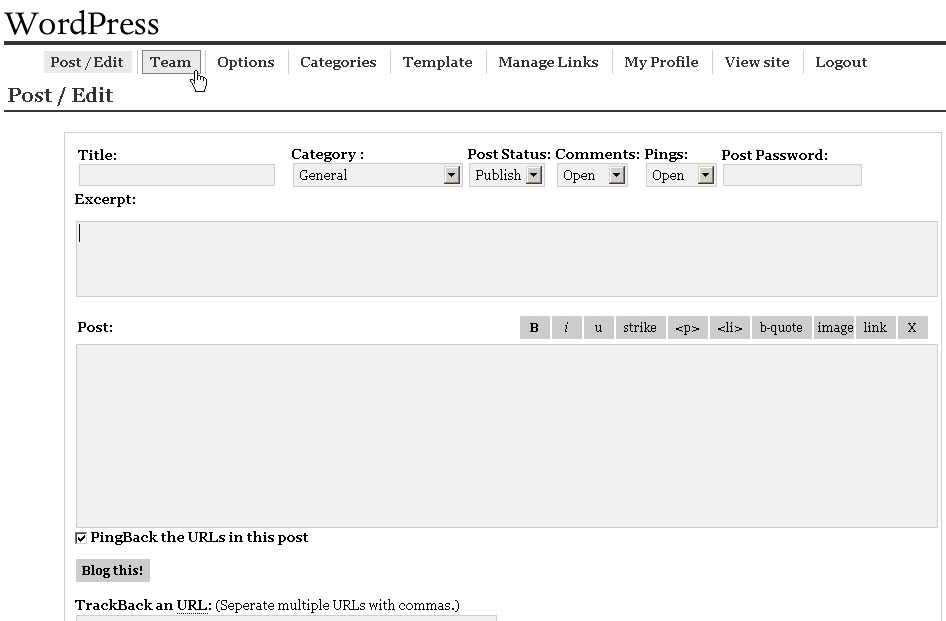
The history of WordPress from its beginning to the present day. Version 1.0
WordPress 1.0.1 – Miles (2004)
Developers began naming major versions of WordPress after famous jazz musicians. Specifically, in this version, you can find the artist Miles Davis. In this version of WordPress, developers stopped using the b2 file structure and moved to their own file structure. As the first major change to WordPress, developers began using pretty URLs and also added the ability to assign multiple categories to a post.
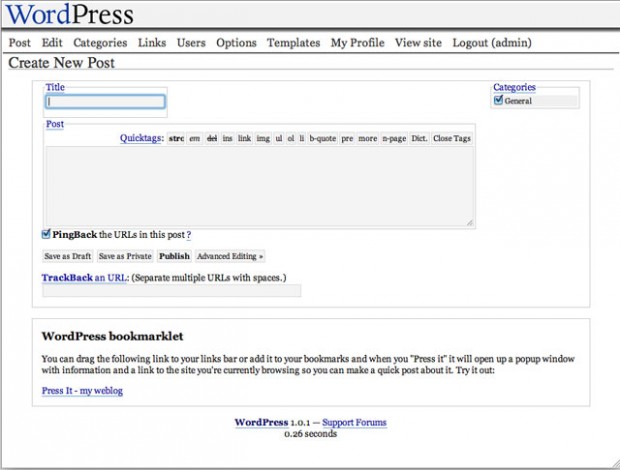
WordPress 1.2 – Mingus (May 2004)
After almost a year, a fairly large update was released, named after Charles Mingus. This version can be seen as a milestone in the direction that we know WordPress today. It was the first time that plugins were used, which have become an integral part of WordPress until today. Other significant changes include the ability to create thumbnail images, subcategories, post previews, custom fields, and encrypted passwords.
WordPress 1.5 – Strayhorn (February 2005)
This version is named after Billy Strayhorn. Here you can see a new style of administration, but it did not use Ajax and was much slower than today’s WordPress versions. In this version, pages were introduced alongside posts for the first time. Additionally, users had the ability to support multiple theme templates and switch between them.
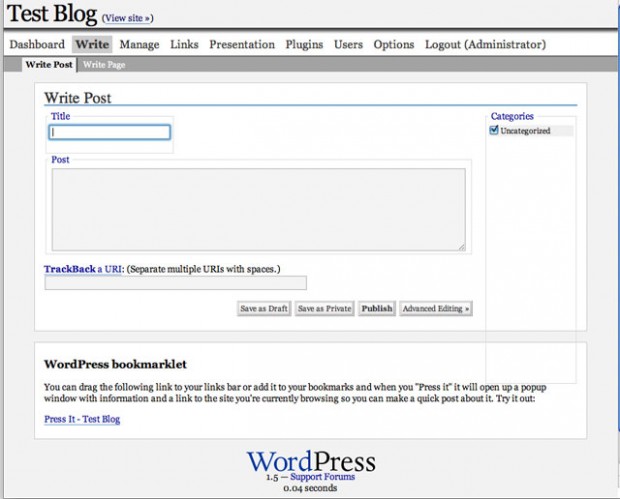
The history of WordPress from its beginning to the present. Version 2.0
WordPress 2.0 – Duke (December 2005)
The Duke version brought a significant change in the administration interface, which began to use a large blue header. Developers incorporated a WYSIWYG editor for people who did not know HTML code, and Ajax was already in use. As a result, the administration of this version of WordPress was much faster than before. Also, to fighting against spam, a new plugin called Akismet was introduced for the first time.

WordPress 2.3 – Dexter (September 2007)
In this version, the native tagging feature and its integration with articles has been significantly improved. You may also notice a new update notification system, allowing the core WordPress and plugins to display notifications when a new version of the core, plugin, or template is available. This version of WordPress finally allows for domain redirection to the correct version specified on the settings tab (with or without www).

WordPress 2.5 – Brecker (March 2008)
The administration of WordPress underwent a significant redesign in this version. For the first time, users were able to upgrade plugins with just one click. Additionally, a much-improved media gallery was used. The WordPress team even collaborated with web design consulting firm Happy Cog to help revamp the user interface of the WordPress administration.

WordPress 2.9 – Carmen (December 2009)
After several updates, this version was released, which allowed users to see the plugin update system on a single click for the first time. This means that you can select multiple plugins at once and update them all at once. You can also see another significant change in image editing, where you can crop, resize, rotate, adjust the size, or flip images.
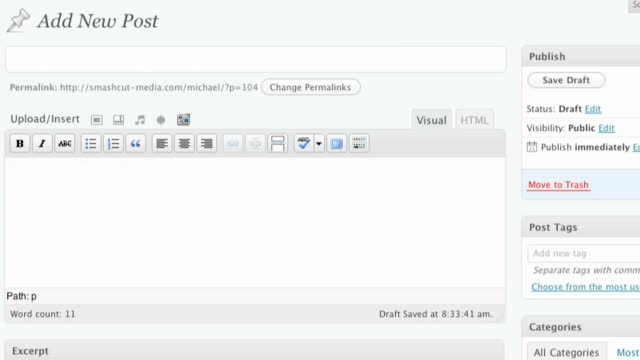
The history of WordPress from its beginning to the present. Version 3.0
WordPress 3.0 – Thelonious (2010)
This update was truly crucial. Here, WordPress finally transforms from a blogging tool into a fully-featured content management system for managing website content. New post types, taxonomies, headers, custom backgrounds, shortlinks, and navigation menus were introduced. For the first time, the native Twenty Ten template was introduced, which started a new tradition of releasing integrated templates named after the year of creation. At the same time, WordPress multisite was also introduced.
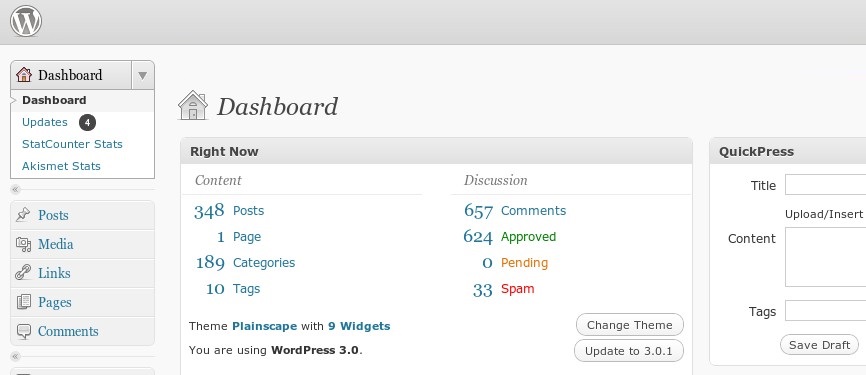
WordPress 3.8 – Parker (2013)
Since 2008, the overall look and feel of WordPress remained largely the same, so the team had to focus on improving it. Developers needed to enhance the platform’s mobile compatibility and accessibility, which was not only important but necessary. As a result, they created a new interface with subtle details that is still used today. They also finally made the platform responsive for mobile devices and added color schemes.
The history of WordPress from its beginning to the present. Version 4.0
WordPress 4.0 – Benny (2014)
In this version, you can see the grid-style interface for media management for the first time, essentially as we know it today.
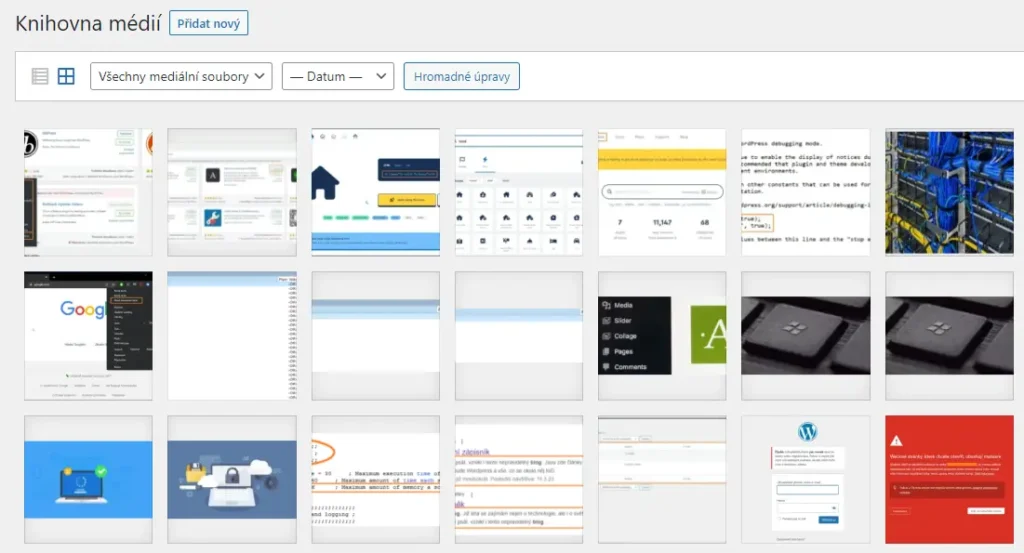
WordPress 4.5 – Coleman (2016)
WordPress 4.5 brought several much-needed improvements to the default post editor. A new feature for editing links within text was introduced.
In the theme editor, responsive previews were added, allowing users to preview their themes on desktop, tablet, and mobile screens without having to switch devices. This made it possible to adjust themes for multiple devices at once without the need to own each device for testing purposes.
WordPress 4.6 – Pepper (2016)
With the release of WordPress 4.6, the development team decided to use native fonts instead of the previously used Open Sans loaded from Google servers.
This release also greatly improved updates, allowing users to install, update, and uninstall plugins or themes without the need to reload the page.
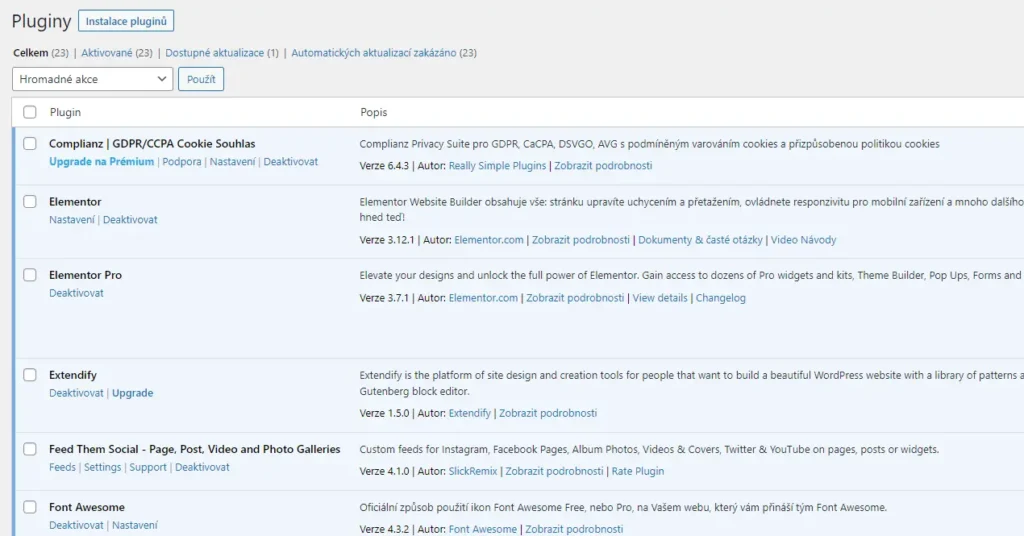
WordPress 4.9 – Tipton (2017)
The last major release of WordPress in 2017 added more features to the theme customizer tool. A new option for browsing and previewing themes directly in the tool was added.
In addition, syntax highlighting and automatic code completion were added to the editor for custom CSS and for editing themes/plugins. This allowed users to write and edit code directly in WordPress without the need for external tools or plugins.

The history of WordPress from its beginning to the present. Version 5.0
WordPress 5.0 – Bebo (2018)
WordPress 5.0 was released in December 2018. It was a significant shift for the system, introducing a new block editor with the codename Gutenberg. Its main goal was to bring a new way of content creation to the WordPress platform. Gutenberg replaced the older TinyMCE text editor and brought users a new experience with creating and editing web pages.
The main advantage of the block editor is that it allows users to easily create and modify individual blocks of content as separate elements. These blocks can then be easily moved, edited, and added to pages and posts. The Gutenberg block editor also brings new options for editing the layout of pages, including new headers, footers, columns, and other elements.
Gutenberg is built on React technology, which allows for a faster and smoother content creation experience. The block editor is also highly flexible and allows users to create their own blocks of content that can be used repeatedly on different pages and posts.
However, the transition to Gutenberg also brought many challenges. Some users, especially those who were accustomed to the older TinyMCE editor version, may have had difficulty with the new block editor. Nevertheless, thanks to extensive documentation and community support, it should be possible to quickly become familiar with the new Gutenberg block editor.
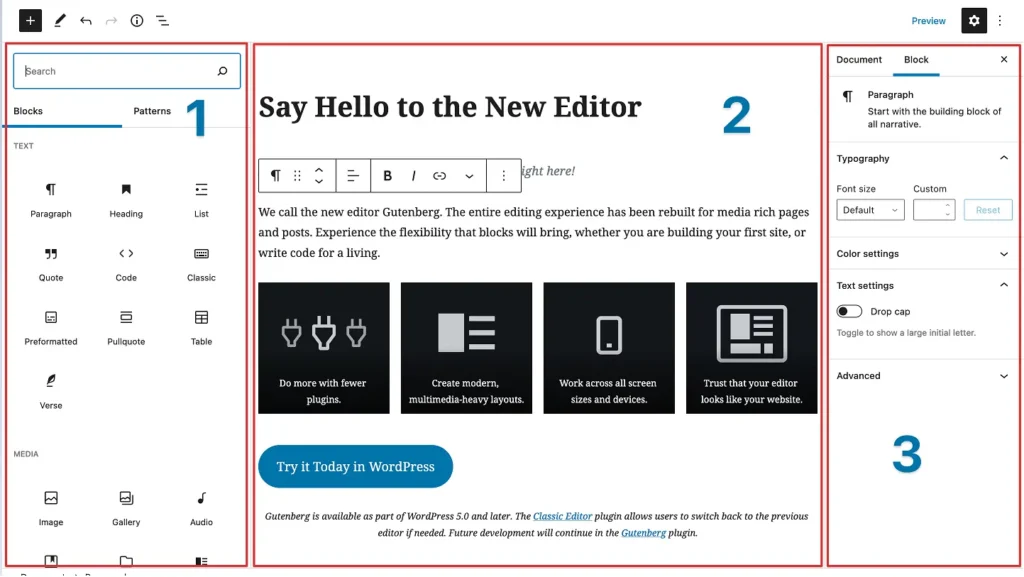
WordPress 5.2 – Jaco (2019)
In 2019, WordPress remained focused on improving its block editor Gutenberg by adding new features, fixing bugs, and enhancing user experience.
With the release of WordPress 5.2, a new feature called Recovery Mode was introduced. Instead of displaying a fatal error, WordPress now shows an error page, which then sends an email to website administrators with a link to access the administration panel in Recovery Mode. This allowed website owners to quickly resolve issues without having to go through many steps to solve the problem.

WordPress 5.9 – Josephine (2022)
This version includes a new native theme called Twenty-Twenty Two, which comes with its own editor for customizing the website’s appearance. However, this editor is currently only in the beta testing phase.
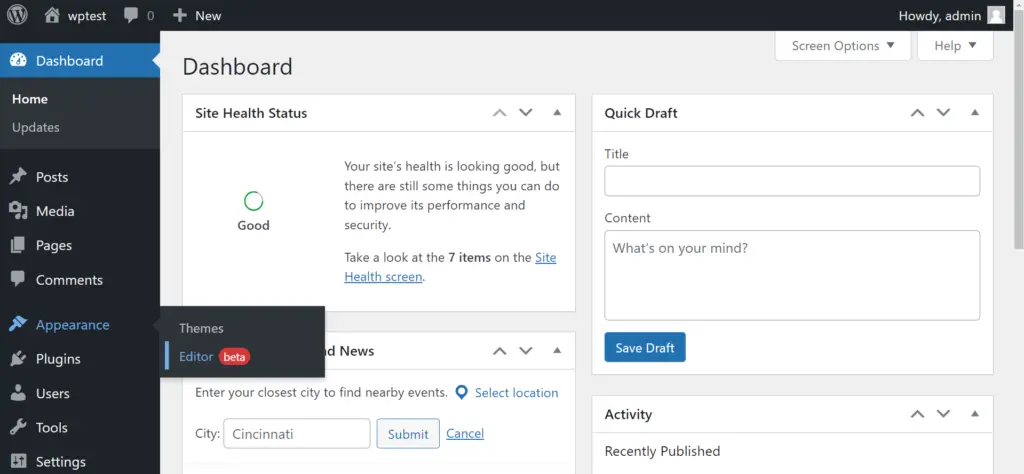
The history of WordPress from its beginning to the present. Version 6.0
WordPress 6.1 – Misha (2022)
WordPress 6.1 was released in November 2022 and continued to improve the web editor. This release did not bring any significant changes to the core or user interface. However, developers added several new tools and improvements to the block editor. They also started working on ensuring consistency in block tools and settings.
The history of WordPress from its beginning to the present. Conclusion
This was just a small list of individual WordPress versions in chronological order. As I mentioned at the beginning, this is certainly not all of them as there have been many versions of WordPress. This list only includes versions that were noteworthy in some way. If you were interested in the history of this content management system, hopefully this article helped you with information on how this system actually started and the direction it has taken or may take in the future.
The website is created with care for the included information. I strive to provide high-quality and useful content that helps or inspires others. If you are satisfied with my work and would like to support me, you can do so through simple options.
Byl pro Vás tento článek užitečný?
Klikni na počet hvězd pro hlasování.
Průměrné hodnocení. 0 / 5. Počet hlasování: 0
Zatím nehodnoceno! Buďte první
Je mi líto, že pro Vás nebyl článek užitečný.
Jak mohu vylepšit článek?
Řekněte mi, jak jej mohu zlepšit.

Subscribe to the Newsletter
Stay informed! Join our newsletter subscription and be the first to receive the latest information directly to your email inbox. Follow updates, exclusive events, and inspiring content, all delivered straight to your email.
Are you interested in the WordPress content management system? Then you’ll definitely be interested in its security as well. Below, you’ll find a complete WordPress security guide available for free.

